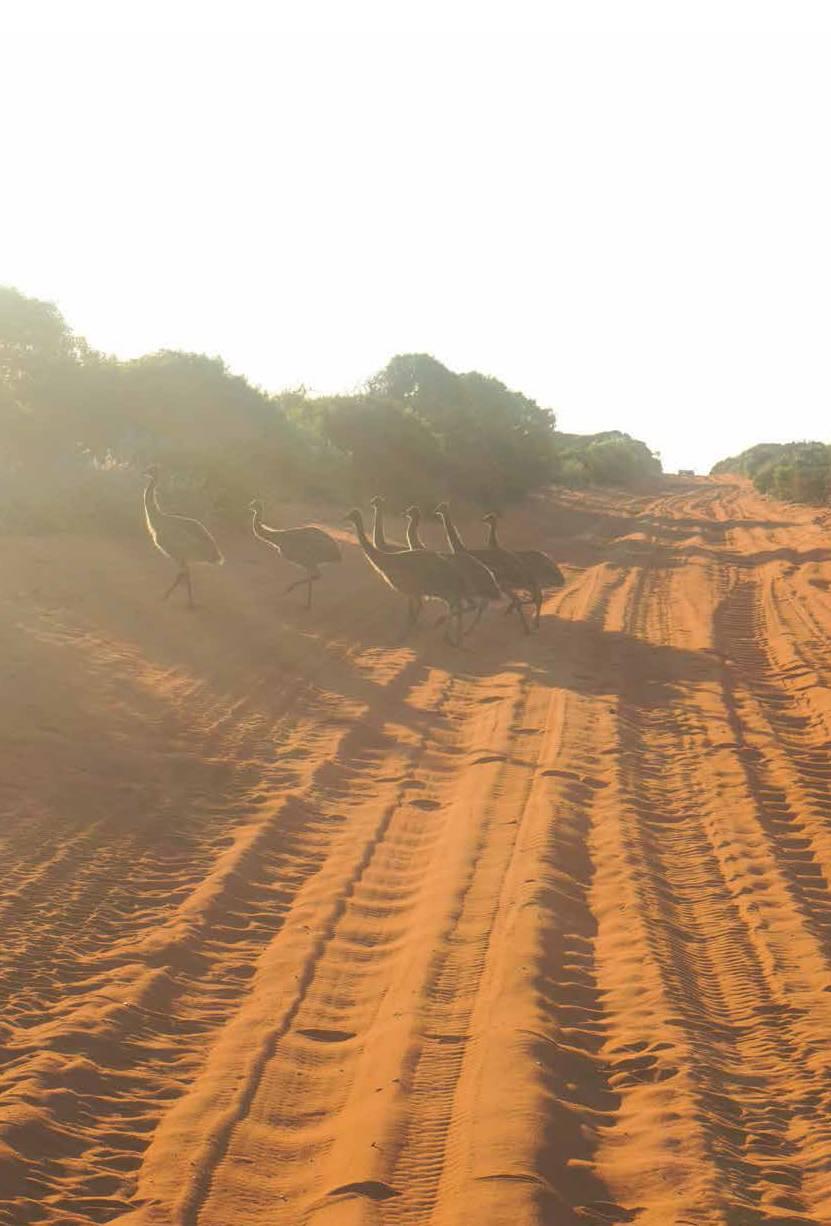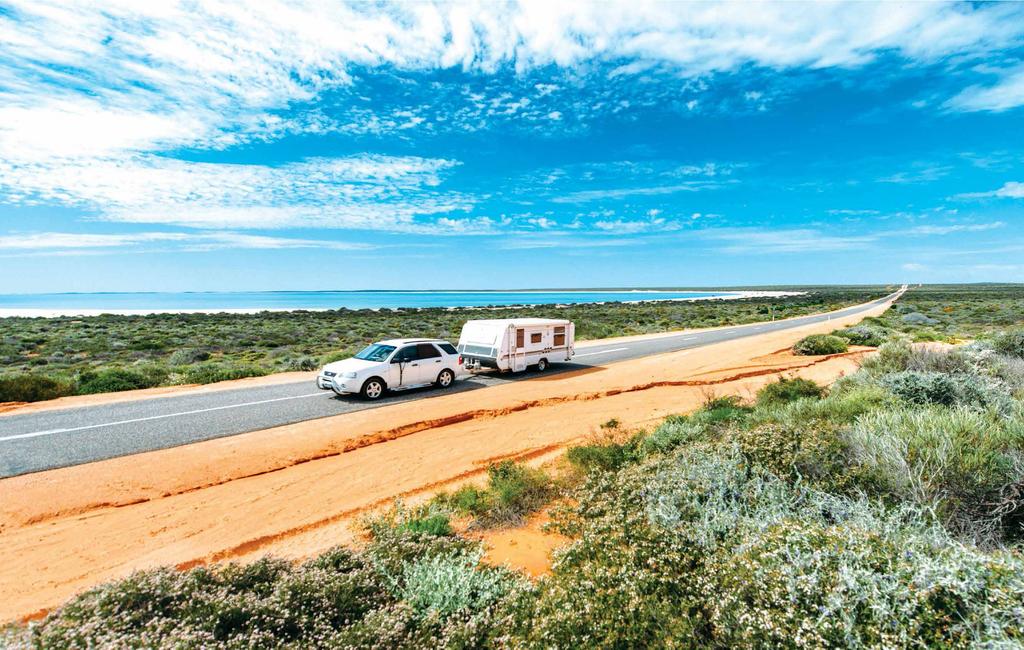Shark Bay, WA: A natural icon
“But, of course, I would be happy to see them,” I quickly followed up to my partner as we crossed over into the 26th parallel, a circle of latitude running east to west 26 degrees south of the equator. We were headed 823km north of Perth along the Coral Coast Highway and had just passed the lone brown road sign that stood on greenlit salt bush plains. In hindsight, it signified more than just a geographical positioning, pit stop photo-op, or edging a nose closer to dolphins.
Shark Bay is Australia’s largest bay, and a place where various magnificent natural phenomena intersect. On a map, the 2.2-million-hectare region appears like two twigs of land sticking out into the Indian Ocean. But across Australia’s most westerly point is a wonderland of natural splendour. It’s an area of striking red, blue, and white hues characterised by diverse sceneries, rare flora and fauna, and magnificent displays of Earth’s ecological processes — some of which are found nowhere else in the world.
A quick wildlife snapshot reveals just how much Shark Bay’s is a sight to behold on air, land, and sea. Seventeen mammal species, 240 bird varieties, 28 shark species, 320 types of fish, 100 kinds of reptile and amphibians, 820 plant types, and 80 different corals are found in one of the country’s most important wilderness areas.
It’s a colourful cove, alright, and it’s more than just playful dolphins or its central hub Denham. Offroad adventures, untamed environments, island escapes, and plenty of wildlife bingo await an area that proves that variety is the spice of life.
Shore thing
The trip straight from Perth is a long one — over seven hours — so it made sense to call it a night at Hamelin Station. The 1884-built outback station stay is the perfect starting block to explore the region, and is just minutes from a permanent pool party.
Hamelin Pool Marine Nature Reserve is home to the world’s oldest living fossils, the stromatolites, surviving 3.5 billion years. It is one of two places on the planet where these rare, slow-growing organisms exist, making it an exceptional place to visit — or not.
We arrived to realise the wooden boardwalk to closer inspect the stromatolites was closed due to tropical cyclone Seroja’s rampage in the Gascoyne region earlier this year. So close, yet so far! Make sure to check with the tourism board, Australia’s Coral Coast, to see when the boardwalk reopens, otherwise, it’s not worth the trip to see specks at sea.
Life soon became brighter and whiter with a trip to Shell Beach. Forever a beach with no footprints, it is beautifully littered with billions of teeny-tiny white Fragum erugatum cockle shells up to 10m deep along its 100km coastline. It is one of two shorelines in the world where you don’t have to stress about getting sand everywhere because there’s a severe lack of it.
Walking across the unusual beach sounded like crunching cornflakes. A sense of amazement fell over me as I tipped these lightweight shells from one hand to another, flowing like sand in an hourglass. I was pouring this extraordinary landscape through my fingertips.
The land of the red, white and blue
Francois Peron National Park is an unlikely marriage of the desert and sea, its vivid red shores wrapped with rings of surrendering white sands and cool blue waters — a heavenly trifecta of colour you must see to believe.
Besides its natural bold colour scheme across steep cliffs to shallow lagoons and all arid shrublands in between, the national park is known for its offroad adventures, beachfront camping, fishing, and swimming. It’s an adventure park, but not for everyone, and that’s a good thing as it keeps the place as wild and pure as it can be.

There are many tracks
A high clearance 4WD is required to navigate most of the national park’s sandy and corrugated tracks, so expect a rocky ride. There are four campgrounds within the park including Big Lagoon. It’s the most convenient to park and ride to explore other areas of the park and town.
“Baby emus!” I shrieked to my partner as we spotted the chain of emus crossing the dirt track ahead. I couldn’t help but coo at the wildly cute family hastily darting to the other side of the tracks. It would be one of many moments seeing them on walkabout, and always met with the same clucky reaction.
As soon as we arrived, I knew Big Lagoon was something special. For $11 a night per person, we managed to score a premium spot lagoon side with a shared raised wooden platform overlooking the motionless setting. It was as if the world had frozen with how still the water appeared — late afternoons tidal movements were another story. Watching the sun disappear behind a mound was reminiscent of a fried egg on a distinct horizon.
Activity wise, the lagoon is great for SUP adventures or fishing, with mulloway being a consistent catch of the day. Unfortunately our rods never reeled in a feed, but there were other prized moments worth more than a good catch.
From here, it was one rusted red road up to explore other areas that make this park such a visual people pleaser. It’s possible to complete a tour of Francois Peron in a day, and the campground is a great base to explore Shark Bay’s other lures — Monkey Mia and Dirk Hartog Island.
Passing South Gregories, Gregories, and Bottle Bay offered the same scenic consistency in the form of turquoise beaches suited for camping, fishing, and kayaking.
At the end of the line are the prized jewels of the park, Cape Peron and Skipjack Point. It’s the money shot here, a picturesque setting of plunging burnt red cliffs dotted with popcorn-like flowering Beaufortia sprengelioides cloaked by white sands and candy waters.
Cape Peron sits at the convergence of two currents, and is a mecca for marine life. There are two viewing platforms to take advantage of the area’s free wildlife show, and my eyes were darting everywhere. There was so much to observe with dolphins, dugongs, turtles, and manta rays spotted loitering the clear waters below within minutes of our arrival.
“Is it a rock? No, it’s on the move!” A small manta ray on a mission caught my eye as it made its gradual excursion around the cliff. And to think we saw all of this on land — how much would we see at sea?
Nearby Skipjack Point affords the most brilliant views of the coastline top of soft red dunes, but be prepared for a leg stretch. Below, a large congregation of Pied Cormorants lined the shore, the tuxedo-looking birds flaunting themselves none the wiser to a clifftop audience.
Goind back to 1616
No trip to the Shark Bay region is complete without going back to the future.
From Denham, we boarded the Dirk Hartog Island Life Adventures vessel to explore Dirk Hartog Island. Peaceful vibes, pristine surroundings, and no people in sight; I felt like a lucky castaway.
Western Australia’s largest island has undergone major ecological rehabilitation to restore its environment to what it was when first discovered by its first explorer namesake in 1616. Reminders of its pastoral history remain with an 1890s-built woolshed and machinery providing a glimpse into its agricultural past. Nearly 20,000 sheep had free rein of the island until 2009, when the island was declared a National Park and the removal of feral animals soon followed. Nowadays, the island is a wilderness retreat for those who like a topsy-turvy 4WD adventure with bite.
Tour guide Casey steered us on an epic wild and bumpy ride to see the island’s spectacular landscapes and hear the ocean roar. The Blow Holes is an intense soundtrack of the sea with massive waves crashing into the cliffs’ fissures.
Surf Point proves why Shark Bay lives up to its name. Dozens upon dozens of grey nervous sharks were spotted lurking and circling the shallow bay, with plenty of fins and tails spotted above the surface. Clearly, it wasn’t a beach to dip our toes in.
But every twist and every bend offered something completely different, and that’s what makes it so exciting to discover. For an extended stay, it’s possible to bring your 4WD and stay overnight, from remote camping to eco-lodge getaways, with bookings recommended to be made far in advance.
The expedition finished with drinks at the island’s beachside bar, Inscription. It had all the feel of a pirate-themed bar, with recycled timber posts, old wine barrels, and nautical relics— not so out of place for somewhere that has returned to life circa 1616.

This region of Western Australia has new marvels at every turn
Playing wildlife bingo
It was time for destination dolphin: Monkey Mia.
The town is most famous for its frequent coastal visits by Indo-Pacific bottlenose dolphins hungry to score a fishy treat. Despite it being a bucket-list encounter, I wanted something less contrived.
It would be an absolute crime to come to Shark Bay without hopping aboard a relaxing cruise of sorts. We hopped onboard the Aristocrat 2, an 18m sailing catamaran, for a marine life cruise with captain Greg pulling out all stops when it came to providing facts with gags.
The area is a vegetarian restaurant for marine life, with 12 species of seagrass found in the region covering roughly the size of the Perth metro area. Fans of the leafy diet include dugongs or ‘ocean cows’ numbering over 10,000 in the bay.
“Mermaids were perhaps inspired by dugongs when the sailors were deprived of ladies attention out at sea,” Greg joked as we spotted dugongs fooling around in their grassy paradise, making their slow ascent for air and blink-and-you’ll-miss-it dive back in. They were flirting with us onboard, and we wanted more.
Dolphins joined in for the ride with a handful swimming beside the bow of the boat. Collective gasps were matched with camera clicks. The dolphins put on a little show with their movements in and out of the water. It would be the closest interaction I would have with any wildlife in the region as they were less than a metre away. I was living for their free-spirited ways. We all were.
But remember — I didn’t come here for the dolphins, right?
Fast facts
DIRK HARTOG ISLAND
LIFE ADVENTURES
P: 08 9948 1211
E: escape@dirkhartogisland.com
PERFECT NATURE CRUISES
Perfect Nature Cruises
P: 08 9948 1446
E: info@perfectnaturecruises.com.au







